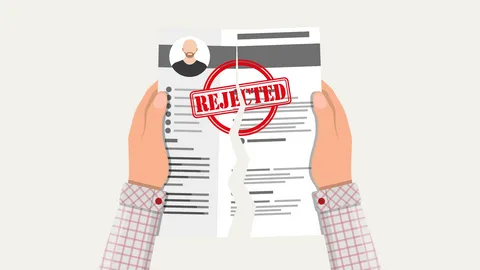Here’s Why a CV Gets Rejected & How to Stop It from Happening
Rejection becomes the fate of your curriculum vitae if you are not wise enough to skip the common mistakes. This statement might be a little too harsh for some people, but it is time for job seekers to realize the gravity of this issue.
The issue is that more than half of the fresh graduates do not know how to pen down a flawless resume. Their document is mostly filled with silly mistakes that they don’t even realize exist. Therefore, this blog is for you, your best friend, your sibling, your neighbour and every person around you who is looking for a job. It is time that we put an end to these CV rejections!
Here’s How to Stop Your CVs from Getting Shelved
Career-related failures feel the same as heartbreaks that come from social bonds. They even bring similar emotions of anger, anxiety, depression, jealousy and sadness. Therefore, before trying to win from it, you must understand its gravity.
One, two, three, four and even five rejections are bearable, but every count about that starts to feel like a truck hit you. This is when you must get rid of your self-blaming behaviour and look out for constructive feedback. This is the only way of progressing.
- Start by acknowledging and processing your feelings. By this, we mean to let the emotion erupt but don’t get carried away into doubting your capabilities.
- Then, very politely ask for feedback from the hiring managers. Their identification of where you went wrong will help you improve.
- Consider their advice and suggestions while you are writing your job application.
- Practice as much as you can and find yourself a mentor.
- Learn new skills and stay updated on industry trends.
In the meantime, you also need to do some research, ask your seniors and reflect on all of your mistakes in the CV.
10 Most Common Mistakes to Avoid
Till the time that you don’t know what the dos and don’ts of resume writing are, you will never know where the mistakes lie. Therefore, either you hire a top resume Canada or carefully familiarise yourself with the commonly identified mistakes of a job application listed below.
Spelling and Grammar Errors:
Not all candidates realize this, but there is a higher chance that their resumes are shelved because of silly typos. They leave a negative impression on the reader and demonstrate a lack of attention to detail coming from the job seeker.
Poor Formatting:
No employer will ever let a resume pass through the shortlisting process, especially if the format is poor. It is like a basic filter that no cluttered and difficult-to-read CVs can pass. So, if you are not spending time to review it thoroughly, start it today.
Standard Resume:
Finding a job is not as easy as going to a shop and ordering a customized position for yourself. It is almost like an uphill battle because of the fierce market competition. This is why sending a one-document-fits-all resume to all the companies is a pathetic idea. You must customize it every single time.
Lack of Specific Achievements:
As simple as this, you will surely get rejected if your final draft lacks the specific details of what difference you have made throughout the years. For this, you can start by listing job duties that you fulfil, but this time with quantifying actions. For example, mention the percentage of sales you helped increase.
Irrelevant Details:
Your documents should appear professional, and there is no space for irrelevant personal information. This extends to the name of skills that are not aligned with the target job role and any other outdated information. Such things only clutter the resume. Hence, they are useless and should be removed.
Using an Unprofessional Email Address:
It is often observed that new graduates do not make a formal, separate email ID to mention in job applications. They use their own personal ones and get tagged as highly unprofessional by the recruiters.
Outdated Information:
Sometimes, when the email address is proper and formal, the other details can be the triggering point for the employers. This happens when the candidate adds in their outdated work experiences. Thus, always ensure that you revise your CV at least three times before submitting it.
Including References:
The references are not a crucial part of the resume. They are rather a very subjective part that can be provided later, upon request. So, it is better not to appear as a dumb candidate by adding things to the resume that weren’t asked for that’s why we should hired a professional resume writers toronto.
Too Much Jargon:
Another common mistake is the open usage of industry-specific jargon that isn’t even remotely related to the job. This means they can make your resume more confusing and less appealing.
Exaggerating or Lying:
Last but not least, once you start writing a professional document, you should keep in mind that the entire content has to be based on truths only. Not even the slightest false and misleading information will be entertained by the recruiters.
The Frequently Asked Questions of a Job Seeker
Q. Why am I getting so many job rejections?
If it is happening for the third time in a row, then there has to be a strong reason behind it. You should look out for your resume. Its format, content, structure, and everything else are important to align with the hiring manager if you want to receive an interview call.
Q. How many job refusals are normal?
Getting refused or not getting a call back from the interviewer is a part of the career. It teaches a person a lot on both professional and personal levels, but it is only acceptable on a 3:2 ratio. This means that for every 3 applications, 2 of them can face refusal on average.
Q. Is it unprofessional to ask why you weren’t hired?
There are no rules that define this action as unlawful or unethical. So, yes, you can ask the employers about why they refused your job profile. However, it is important that you approach the question very politely and with the intention to learn and improve.
Q. What does an excellent CV look like?
An excellent resume has the following qualities: well-structured, easy to read, customized for the target company, aligned with the company’s vision and to the point. Moreover, it should present your skills, experience, and achievements in two pages.
Summarizing the Common Mistakes of CV Writing
There are several mistakes that both fresh graduates and established employees make while writing a CV. Some of them were discussed in the blog above, such as formatting errors, the inclusion of irrelevant data, unprofessionalism, and so much more.
All of these things might seem trivial, but they end up costing you a job position. So, before it is too late, you need to understand why your resume is being rejected repeatedly. This will help you identify the common mistakes and then avoid them in future job proposals.







